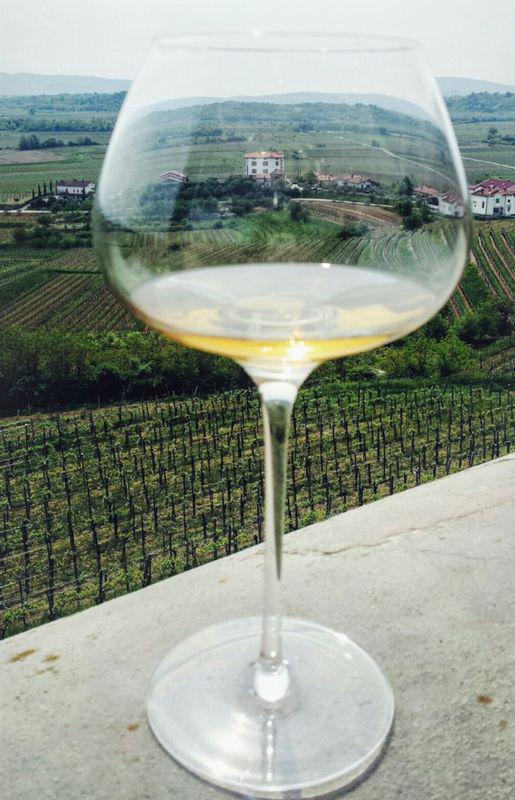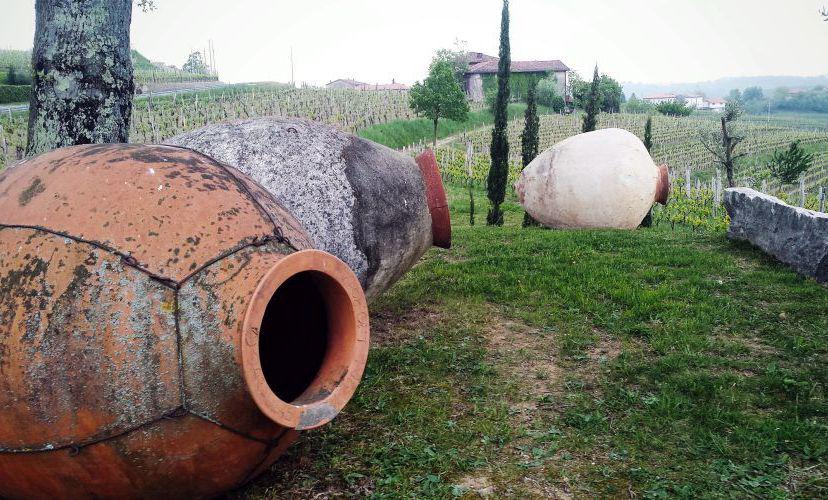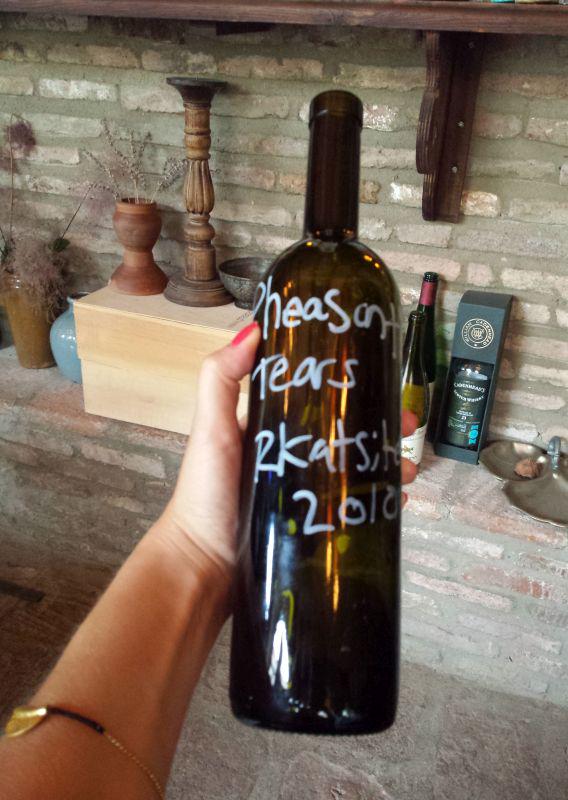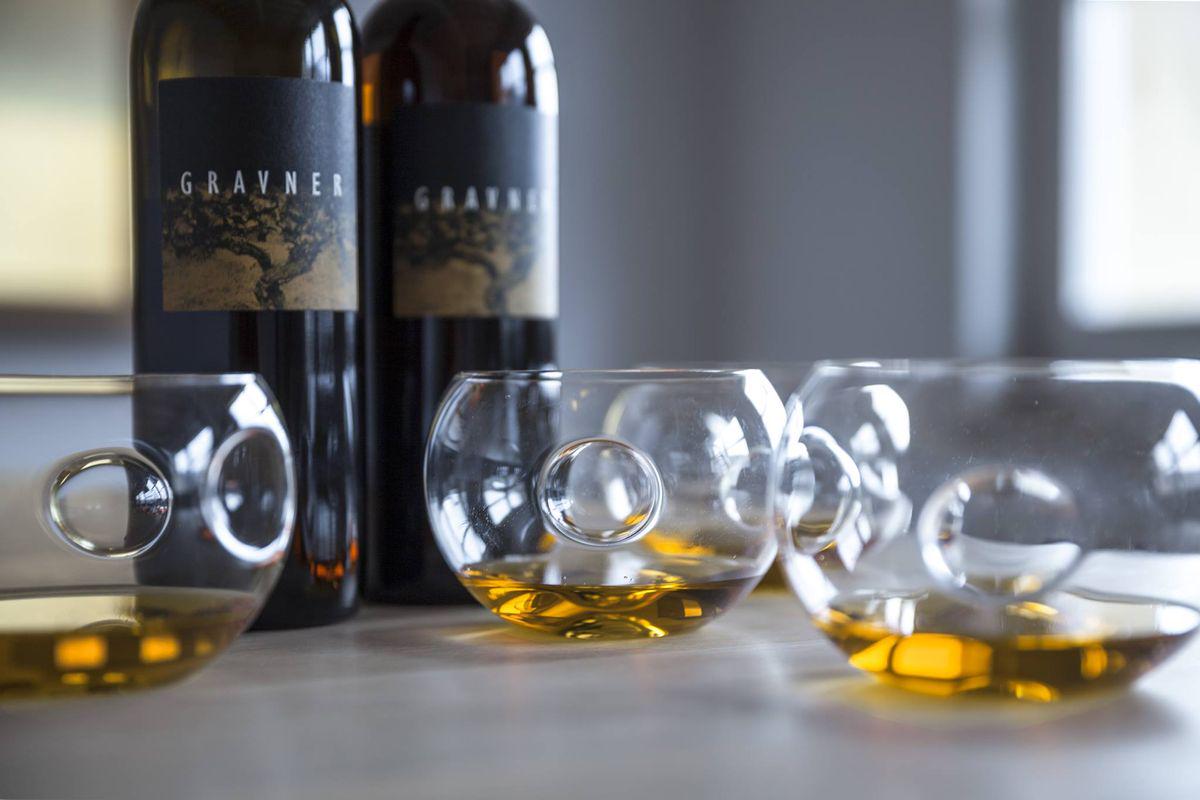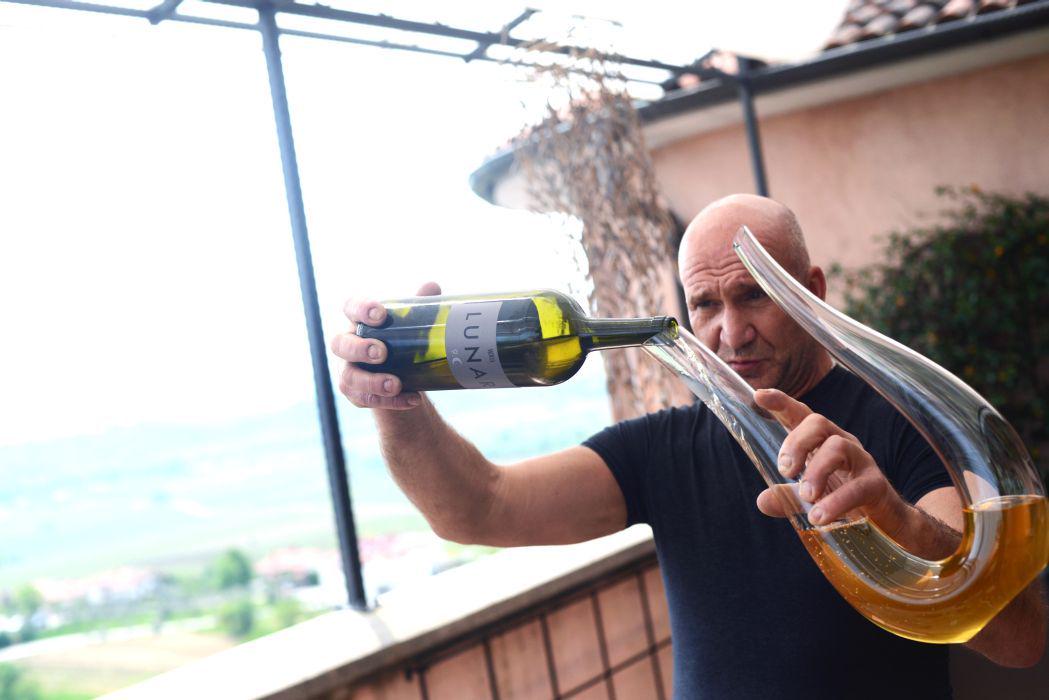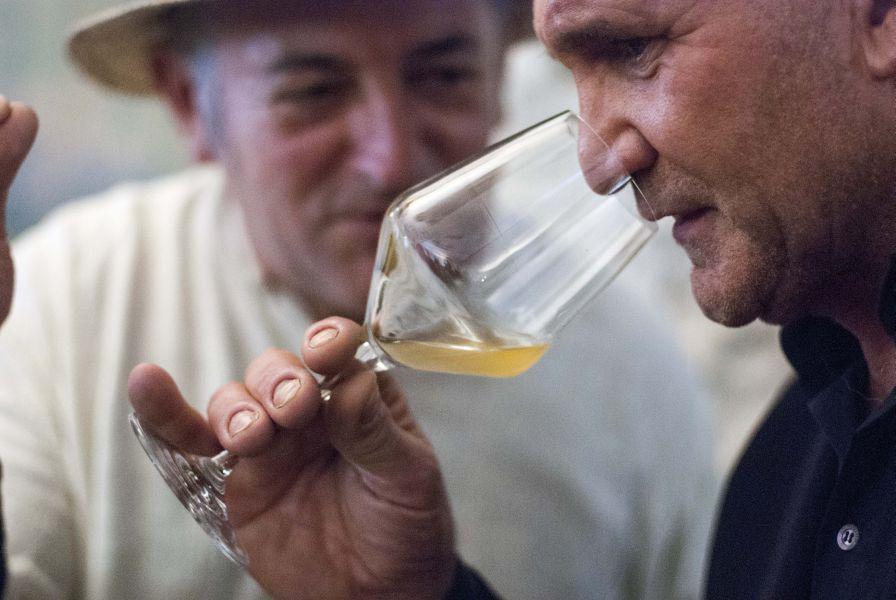
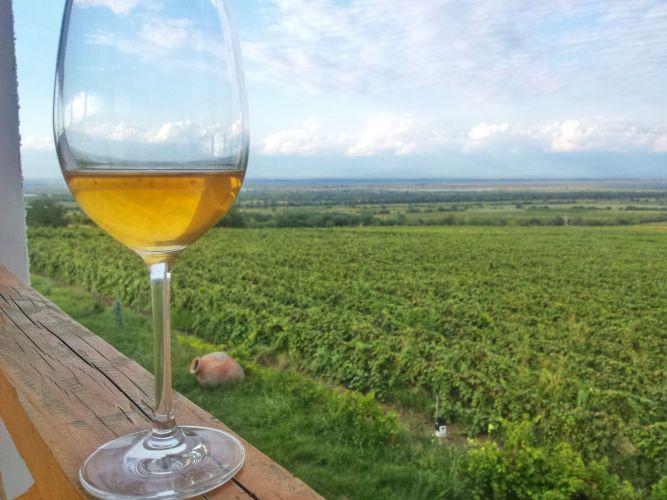
Renčel: Cuvee Vincent 2001 Mlečnik: Cuvee Ana 2010 Movia: Lunar 2007 Rebula (magnum) Klinec: Ortodox 2006 JNK: Chardonnay 2007
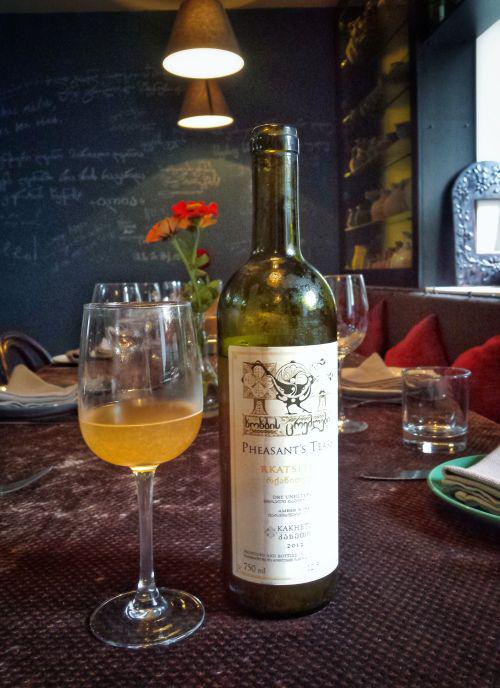
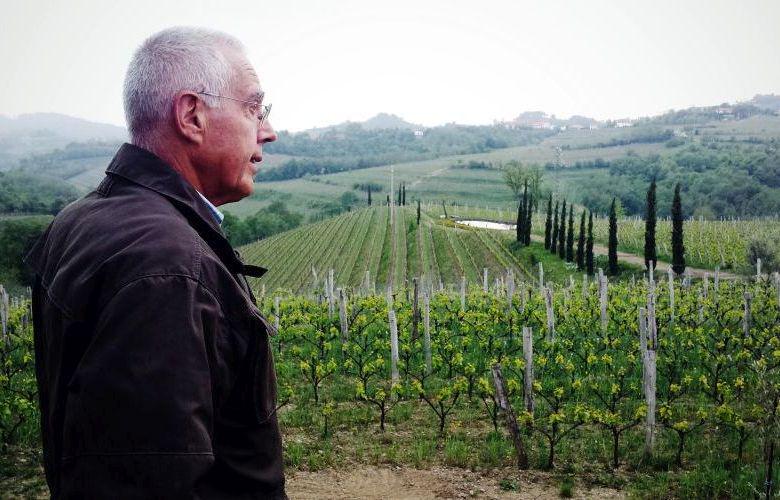
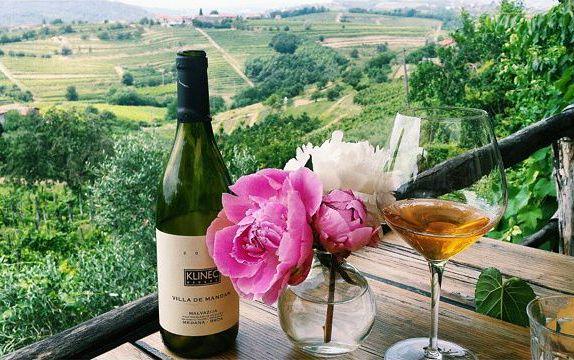
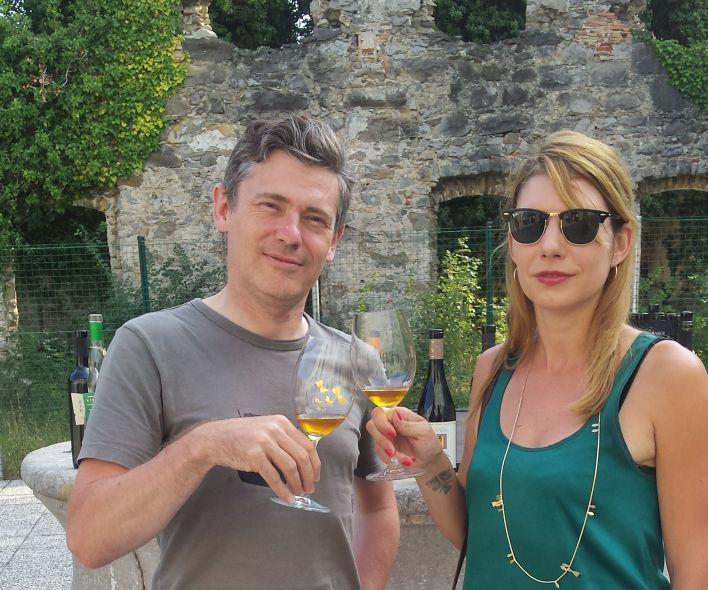
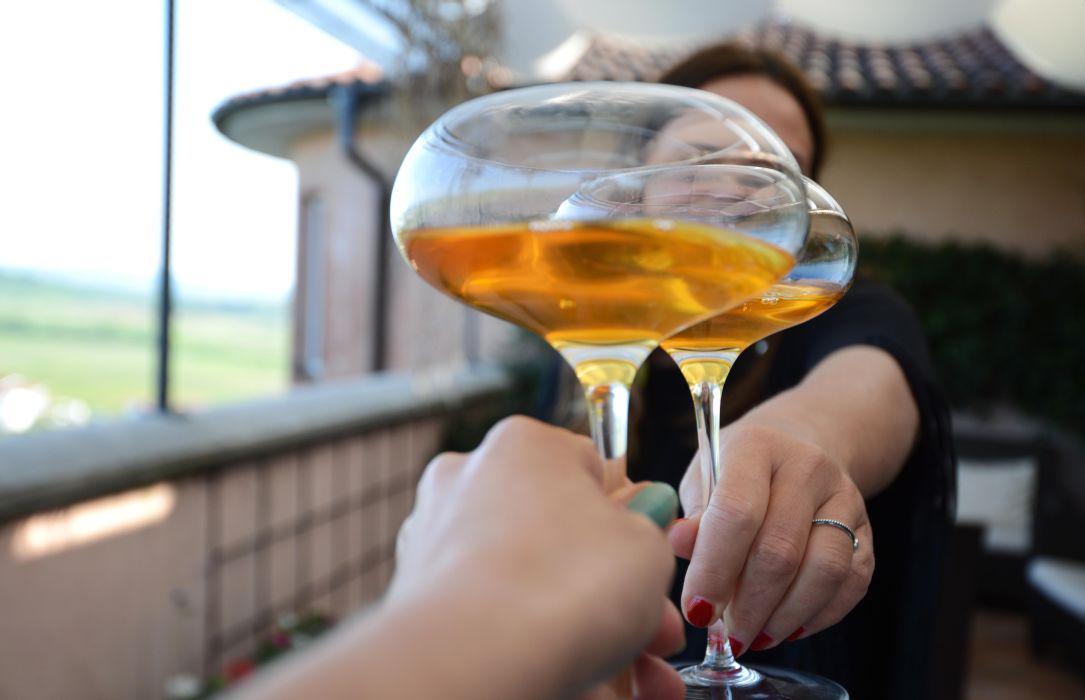

His book, for which he has been collecting data, comparisons, and impressions for four years, opens with the chapter about the Slovenian-Italian border, a haven for amber hued and natural wine.
And Woolf does not hide his favourites – Joško Gravner, Stanko Radikon, Valter Mlečnik … exciting names for anyone who loves natural wine and skin contact wine. They were the pioneers who were producing orange (or amber, as they prefer to call it) wine long before it became the latest hipster fashion trend.
We spoke with Woolf in Vipava Valley before today's official launch of his new book.
Sidenote: In November, the British writer, a contributer to Decanmter magazine, organizes a week-long tour around western Slovenia by visiting the best natural winemakers.
"How the world learned to love orange wine" is the subtitle of your book. Let's start here. Do you think the world really has learned to love it?
Of course the subtitle is meant to be a little provocative. But, yes there are now orange wine fans and enthusiastic winemakers around the world who adore this style and seek it out. 20 years ago, no-one had even heard of it. Orange wine may still be niche, but it has a truly global audience.
What attracted you to orange wine, how did you develop the taste for it? Was it love at first sight or more of a process?
It wasn't quite love at first sight. I first seriously tasted orange wines in the village of Prepotto in Carso, in 2011. I was in Sandi Skerk's cellar when the lightbulb moment came. I didn't know what I had in my glass, I just knew it was completely different than anything I'd ever tasted before. I wanted to understand it better. It didn't take me long to fall in love though.
Some say - once you go orange, you never go back. True?
It can certainly turn into an addiction. I've had evenings in winebars where there was nothing orange on the list and I just couldn't find anything that satisfied my tastebuds. But I do enjoy many other styles of wine too.
Amber Revolution opens with the chapter on Friuli and Slovenia border and you give a lot attention to Slovenia in your book. Are Slovenian wines a hidden gem or are they leading the pack among the connaisseurs?
The hidden gem is Slovenia's natural and orange wine producers. Slovenia has been marketing itself as a producer of modern-style squeaky-clean wines, where in reality it ought to be concentrating what really makes it unique, which is its grand tradition of macerating white grapes. Times are changing, and I see Slovenia being more and more recognised as the beating heart of orange wine. It helps that more tourists are coming and discovering Slovenia's artisan producers for themselves.
In the past few years orange wines are equally adored and hated. They have become trendy in some circles, at the same time wine critics and reviewers, especially old school wine critics, often frown upon them. Jay Rayner compared natural wine to “an acrid, grim burst of acid that makes you want to cry”. Robert Parker called it an “undefined scam”. You yourself are contributer to Decanter magazine and Decanter is not exactly known as the biggest orange or natural wine supporter ...
Decanter think their readers only want to drink Bordeaux and Burgundy (with the occasional glass of Riesling or Barolo when they want to feel exotic). I'm trying to convince them they're wrong but it's a slow process.
I think the days of kneejerk reactions from old hacks are dwindling, but there are still a lot of wine professionals out there who can't get their heads around any change to the status quo. There's a whole chapter about this in my book!
To detractors, natural wine is "a form of luddism, a sort of viticultural anti-vax movement that lauds the cidery, vinegary faults that science has spent the past century painstakingly eradicating" to quote a recent Guardian piece on that subject. Why is natural and skin contact wine considered so radical in an era when "eco", "sustainable" and "green" defenitely aren't dirty words?
Because it's a reversal of what educators and scientists have been teaching in the post-war industrial era. Some commentators remember back to the 1960s and 1970s when you couldn't rely on wine always being even drinkable. For them, the big revolution was the 1980s, when wine science really came of age, and quality improved the world over. I can understand they have a hard time accepting the faults in wine that the previous generation spent trying to correct. But the counter-argument is that bland homogeny is boring. A lot of the character in wine comes from not doing too much, from just letting the fruit speak and trying not to intervene. Skin maceration is a vital technique that allows this kind of minimal intervention winemaking to happen much more easily.
Are you more of a fan of elegant orange wines or radical ones?
It depends on my mood. And even a radical wine can still have elegance. Radikon's "Oslavje" often achieves that combination.
In Slovenia (border included) which wine sort excites you most? Which winemaker or which wine has so far been the nicest or most unexpected surprise?
The Karst region is vastly underrated. The steely, mineral focus of the wines there is extraordinary. It's truly a unique and powerful terroir.
My biggest surprise came last year, when I first met Andrej Cep (Gordia). His manner is so casual and humble, and then you taste the wines - wow!
It's hard to talk about orange (amber, he prefers to call them) wines and not talk about Joško Gravner and Stanko Radikon. Anywhere you go you hear the orange winemakers cite them as the biggest influence. What is it about the two of them that makes them so influential?
They had the balls to change everything, out of a strong desire to achieve a more authentic, regionally resonant result, at a time when everyone else was still in love with Chardonnay, selected yeasts and new French oak. And they didn't do it in half measures. Both went all or nothing for what they believed in.
Speaking of Gravner and Radikon, so often mentioned in the same sentence - they have (had) slightly different philosophy about adding sulphur. Stanko insisted on no sulphur, Gravner says it's essential. In small quantities, of course. What's your opinion on this issue that divides so many?
It's a shame that this issue can be so divisive. Actually Stanko and Saša have always made it clear that they are not dogmatic about the use of sulphur or not. The S-line wines are still made with a little added SO2. Stanko worked for years to get to a point where he could remove sulphur from the process. He didn't just wake up one morning and decide. Joško is of course strong-willed, and insists that one must use a little sulphur. When I taste his wines, I know he made the right decision because they're delicious.
If you're an orange wine lover, what would you say are essential wineries you absolutely have to visit once in your lifetime?
There are so many! But historically, Gravner, Radikon, Vodopivec, Mlečnik, Movia are maybe the most seminal. A trip to Georgia is essential too.
Do you visit Orange, Raw and other natural wine festivals? What do you think of the selection there? Some are saying the organizers aren't strict enough with the selection, some are complaining about the occasional additions of winemakers that aren't exactly orthodoxly natural winemakers ... What's your opinion on that?
Yes, I attend a few fairs. I get very frustrated when I hear these kind complaints. It's stupid and cliquey - "You use blue widgets and we use red ones, so you can't be in our club". It's better for consumers and for winemakers to have a broader range to compare and contrast. We can all make our own decisions about whose philosophy we prefer. There's a very vibrant artisan wine fair held in Porto every February called "Simplesmente Vinho". They specifically invite a few more mainstream producers, in the hope that they'll be inspired and infused by all the hardline guys who are more experimental. It's about cross-pollination. How does anyone learn to improve and push things forward if you just bar them from your circle?
Can you name maybe five wines from Slovenian winemakers that completely blew you away - and why?
Renčel - Cuvee Vincent 2001 - stunningly elegant, perfect maturity
Mlečnik - Cuvee Ana 2010 - Maybe the best ever vintage of this classic. It's got that tight, structured core that only Rebula can provide, and really lipsmacking acids.
Movia - Lunar 2007 Rebula (in magnum) - gentle, nuanced, really fine.
Klinec - Ortodox 2006 - sensational, complex and defined
JNK - Chardonnay 2007 - a honeyed, concentrated beauty with such pure fruit and long length.
"What they (the fans of natural and skin contact wine) deem “bad” wine is really wine that tastes good, at least to large numbers of drinkers. And what’s so bad about that? What is wine but a drink of pleasure?" wrote Bianca Bosker, an American sommelier in the NYT opinion section and set off a fury among the natural wine lovers. What would you say to an opinion like that?
This is such a gross over-simplification and total misunderstanding of the whole natural wine ethos that I don't know where to start. Most natural wine fans are simply looking for honestly made wines that provide pure drinkability. Drinkability isn't a given in fine wine. Italians have this wonderful phrase "vino di meditazione" for wines which are super-powerful, layered and complex. But be careful. Sometimes if someone uses that term, it can be "damning with faint praise". They are signaling that the wine is only good for sipping, and contemplation. Drinkability is about taking a bottle out into the sun on a hot day, and glugging it down merrily with your best friends. Who wants to do that with a Super-Tuscan Merlot that's been aged in new oak for a million months?
Where do you see the next hotspot for natural and skin contact wines? Who is doing some really good work and has not been really recognized yet by the crowds?
Austria is slowly but surely becoming one of the greatest wine producing countries for natural and orange wines, outside of Italy and Slovenia. It's one of very few countries where you really find specialists in skin contact. Within Italy, the producers in the Colli Piacentini area (La Stoppa, Denavolo, Croci, Andrea Cervini, Ca’ de Noci etc) deserve more recognition, as a really homogeneous group of natural winemakers showing the greatness of macerated Malvasia di Candia. Slovakia is definitely up and coming, with enthusiastic natural winemakers and fascinatingly individual results.
Why do you think the Slovenian-Italian border is so strong in the area of natural and skin contact wines? What is it about that area, the people, the soil ...?
It has a lot to do with Rebula - the grape variety with skins so thick, you couldn't press it unless you macerated first. And also, as I argue in my book, it's about the resilience and determination that people in this region have needed over the last century. It's quite literally been through the wars, and people had to fight for their very identity. You can see that in the philosophy and the wines.
How often do you come to Slovenia? Who are you eager to visit on your next stop in our parts?
Not often enough! I usually manage 2-3 times a year. I want to explore Štajerska and the South-East more. These are regions I barely know.
Renčel: Cuvee Vincent 2001 Mlečnik: Cuvee Ana 2010 Movia: Lunar 2007 Rebula (magnum) Klinec: Ortodox 2006 JNK: Chardonnay 2007




















































